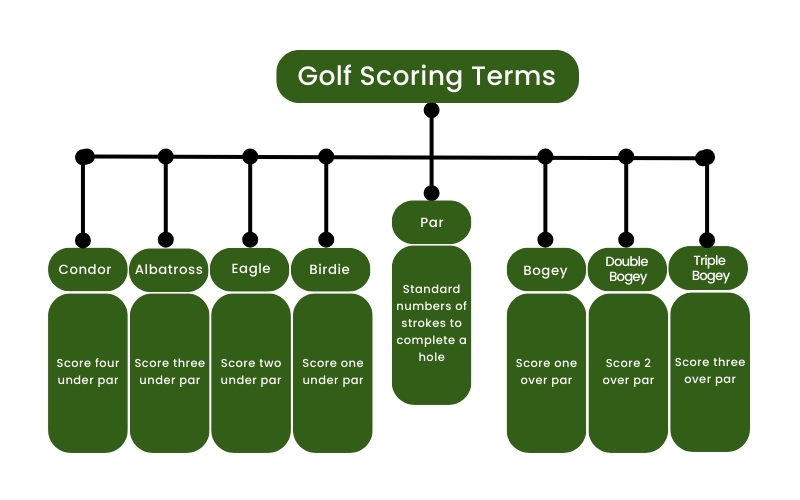Golf Scoring Terms: What is a Birdie, Bogey, Eagle & Par?

If you’re just starting out in golf, you might find yourself puzzled by golf scoring terms like birdies, bogeys, eagles, and pars. Wondering what they mean? What is a birdie? How is it different from the others? Let’s see in the following article.
Recently, 22-year-old Swede Linn Grant made history by becoming the first female player to win a mixed-gender event on the European tour. Competing against both men and women, she clinched her victory with an impressive 8-under par 64 in the final round at Halmstad Golf Club in Sweden. Grant completed her final round without a single bogey and achieved birdies on five of her first six holes, finishing the tournament at an astounding -24, a full 9 strokes ahead of the runner-up.
That’s an amazing score in golf! But with all the different golf formats out there, it can be tough to know why exactly it’s so impressive. Let’s break down what these scoring terms mean so we can truly appreciate this golfer’s incredible achievement!
Must-Know Golf Scoring Terms
Before diving into golf terms for scoring, it’s crucial to understand what a stroke is. In golf, a stroke represents each time a golfer swings their club to hit the ball, including any swing intended to hit the ball, even if it misses. This fundamental concept is the backbone of golf scoring. Every scoring term you’ll learn about relates to the number of strokes a golfer takes compared to par, a term we’ll explore shortly.
Below are 8 must-know golf scoring terms:

Golf scoring terms
What is Par in Golf?
In English, “par” means standard or average, but in golf, it takes on a distinct meaning.
A golf course is typically designed with the expectation that an expert player can complete 18 holes in about 72 strokes. On a par-3 hole, the expectation is one stroke to reach the green followed by two putts. For par-4 holes, it’s two strokes to the green and two putts, and for par-5 holes, three strokes to the green plus two putts. Sounds straightforward, right?
However, achieving par is challenging for the average golfer. The United States Golf Association (USGA) defines a par golfer as “a player who can play to a Course Handicap of zero on any rated golf courses.” Essentially, shooting par requires significant skill.
Wondering about the Course Handicap or the handicap system? This system is used at most courses and in amateur tournaments to level the playing field, allowing each player to deduct their handicap from their actual score to make the game competitive and enjoyable for everyone.
If someone asks about your handicap, they’re not referring to physical limitations. A golf handicap is calculated based on your scores from at least six rounds of play. For instance, if your scores are 89, 92, 96, 91, 97, and 88, your average score is approximately 93.66, rounded to 94. If you’re playing on a par 72 course, your handicap would be 22, which is quite respectable.
Ultimately, whether you’re playing at par, above, or below, golf is about more than just the numbers. It’s an opportunity to enjoy the outdoors, share in camaraderie, and get some exercise – all of which make a day on the course worthwhile.
What Does it Mean to be Under Par?
Achieving a score under par signifies a remarkable level of golfing prowess. For instance, if the course is a par 71 and you score a 68, you’re three strokes under par – truly an impressive feat. Congratulations are in order! This accomplishment generally indicates you’re an experienced golfer, likely achieving scores under par on several individual holes throughout the round.
There are various golf scoring terms for being under par, each one indicating an even greater level of skill than the previous.
Birdie. What is a Birdie in Golf?
It’s interesting to note that scoring one under par in golf is called a “birdie.” No, you won’t actually receive a bird, but that’s the lingo. Sounds odd, right?
The term dates back to 1903, as noted on a plaque at the Atlantic City Country Club. The story goes that a golfer named Ab Smith hit a remarkable shot that landed just six inches from the cup and exclaimed, “That was a bird of a shot!” Impressed by the beauty of the shot, he suggested that shooting one under par on a hole should earn “double compensation.” The next time someone in the group achieved this, they referred to it as a “birdie.”
The term quickly caught on at the country club and spread worldwide. Typically, birdies are seen when an excellent approach shot to the green sets up a short putt. However, impressive long-distance birdie putts happen too, like Louis Oosthuizen’s stunning 65-foot putt at the Honda Classic in February 2022. Incredible, isn’t it?
Eagle
AB Smith is also credited with coining the term “eagle,” which signifies scoring two under par on a single hole. Eagles typically occur on par 4 holes when a golfer successfully chips in from close to the green.
To put it in perspective, just as an eagle is larger than a birdie in the natural world, in golf, scoring an eagle is a greater achievement than scoring a birdie.
Albatross
Let’s delve even deeper into under-par achievements. In golf, an “albatross” describes a score of three under par on a single hole.
In the history of golf majors (Masters, US Open, British Open, PGA Championship), only 18 players have recorded an albatross. Among them is Louis Oosthuizen, who achieved this rare feat most recently at the 2012 Masters. Before him, the last player to score an albatross at the Masters was Jeff Maggert in 1994. Notably, Jeff Maggert is also the only player to have recorded two albatrosses, achieving his second during the 2001 British Open.
Condor
If you thought an albatross was an exceptional score, consider the even rarer possibility of scoring a condor, which is four under par on a single hole. The first documented condor was achieved by Larry Bruce in 1962. Other golfers who have joined this exclusive club include Dick Hogan in 1973, Shaun Lynch in 1995, Mike Crean in 2002, and Jack Bartlett in 2007.
In 2020, professional golfer Kevin Pon made headlines by scoring a condor with a two-stroke shot on the 667-yard 18th hole at Lake Chabot Golf Course in Oakland, California, marking a remarkable achievement on a rare par-6 hole.
Scoring consistently under par, like achieving birdies or better, remains a formidable challenge even for seasoned golfers. For instance, during the 2020 Masters, Australian golfer Cameron Smith became the first player to record all four rounds in the 60s – yet he only managed to tie for second place. Such feats underscore the difficulty and rarity of playing consistently under par in professional golf.
What Does It Mean to be Above Par?
In the grand scheme of golf, shooting above par is quite common and places you in the majority of golfers. For example, if the course is rated at 70 and you score 71 or higher, you’re considered to be playing above par.
Bogey
A “bogey” is scoring one over par on a single hole, like recording a 5 on a par-4 hole. Playing “bogey golf” means you average one over par across all holes. For a par 72 course, this would typically result in a score of around 90.
Double Bogey & Triple Bogey
A “double-bogey” is scoring two over par, such as a 5 on a par-3 hole, while a “triple bogey,” often humorously referred to as a “snowman,” is three over par, like scoring an 8 on a par 5.
Even the best golfers have their off moments. For instance, in 2013, Jason Dufner, after winning the PGA Championship, unexpectedly tapped his birdie putt sideways on a par 4. Such blunders are part of the game.
And just for clarity, the term “duffer,” which denotes a less skilled golfer, isn’t derived from Jason Dufner’s nickname “Duff,” though his unfortunate putt might remind some players of the times they’ve had a potential eagle that ended up as just a birdie.
Read more:





